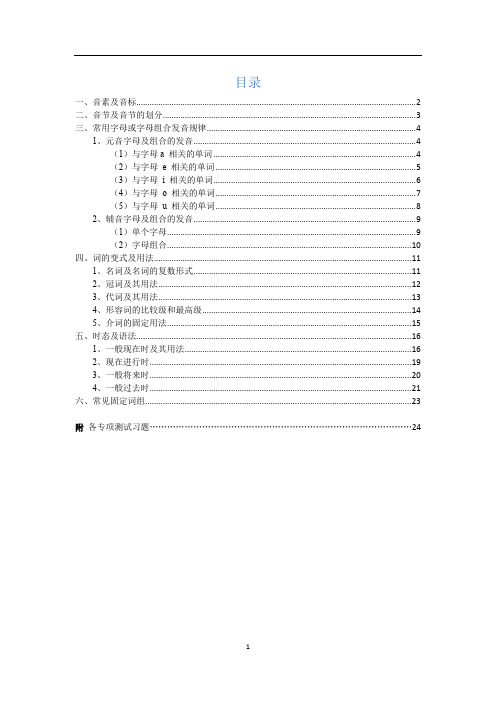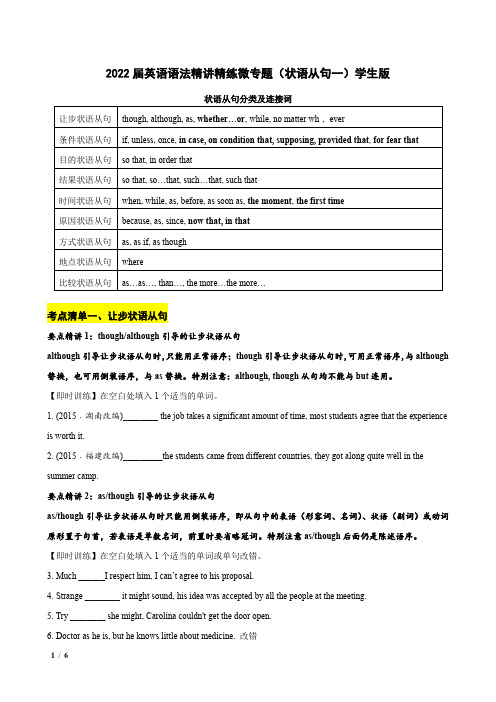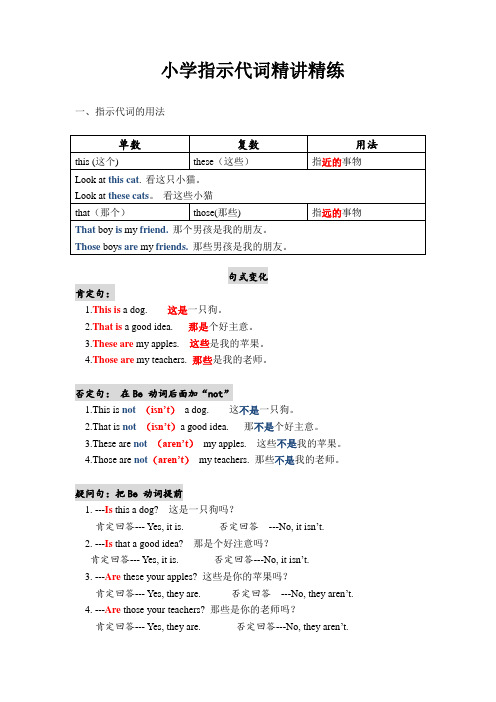小学英语语法知识点_精讲+精练
(完整版)人教版小学英语语法知识点汇总

目录一、音素及音标 (2)二、音节及音节的划分 (3)三、常用字母或字母组合发音规律 (4)1、元音字母及组合的发音 (4)(1)与字母a 相关的单词 (4)(2)与字母 e 相关的单词 (5)(3)与字母i 相关的单词 (6)(4)与字母o 相关的单词 (7)(5)与字母u 相关的单词 (8)2、辅音字母及组合的发音 (9)(1)单个字母 (9)(2)字母组合 (10)四、词的变式及用法 (11)1、名词及名词的复数形式 (11)2、冠词及其用法 (12)3、代词及其用法 (13)4、形容词的比较级和最高级 (14)5、介词的固定用法 (15)五、时态及语法 (16)1、一般现在时及其用法 (16)2、现在进行时 (19)3、一般将来时 (20)4、一般过去时 (21)六、常见固定词组 (23)附各专项测试习题 (24)一、音素及音标音素:英语把组成一个读音的最小单位叫音素。
因素分为元音和辅音(相当于语文中的韵母和声母)1、元音(韵母)1.1发音方式:靠声带发音,有声调,气流通过喉头、口腔不受阻碍。
1.2举例:元音单元音长元音[a:][ә:][i:][ɔ:][u:]短元音[Λ][ә][i][ɔ][u][æ][e]双元音[ai][ei][ɔi][iә ][eә ][uә ][au][әu]1.3元音的结构元音的常见构成有:组合方式举例1单个元音字母D o g2元音字母+元音字母S ee、s ea、m ea t、b oo k3元音字母+辅音字母T al l、pl ay1.4元音字母共有5个,分别是:a e i o u2、辅音(声母)2.1发音方式:主要是用气流与牙齿舌头等其它器官摩擦发音,气流通过喉头、口腔要受到某个部位的阻碍。
2.2举例:辅音10对清辅音[p] [t] [k] [f] [s] [∫][t∫][tr] [θ][ts]浊辅音[b] [d] [g] [v] [z] [ʒ][dʒ][dr] [ð] [dz] 3个鼻音[m] [n] [η]3个似拼音[h] [r] [l]2个半元音[w] [j]2.3辅音的结构组合方式举例1单个辅音字母D og、b ook2辅音字母+辅音字tr ee、dr aw、tea ch、sh ip 2.4辅音字母26个字母中,除去5个元音字母(a、e、i、o、u),其他字母都是辅音字母。
2022届英语语法精讲精练微专题 (考点清单+精讲+好题回顾)--状语从句一(学生版)

2022届英语语法精讲精练微专题(状语从句一)学生版状语从句分类及连接词考点清单一、让步状语从句要点精讲1:though/although引导的让步状语从句although引导让步状语从句时,只能用正常语序;though引导让步状语从句时,可用正常语序,与although 替换,也可用倒装语序,与as替换。
特别注意:although, though从句均不能与but连用。
【即时训练】在空白处填入1个适当的单词。
1. (2015﹒湖南改编)________ the job takes a significant amount of time, most students agree that the experience is worth it.2. (2015﹒福建改编)_________the students came from different countries, they got along quite well in the summer camp.要点精讲2:as/though引导的让步状语从句as/though引导让步状语从句时只能用倒装语序,即从句中的表语(形容词、名词)、状语(副词)或动词原形置于句首,若表语是单数名词,前置时要省略冠词。
特别注意as/though后面仍是陈述语序。
【即时训练】在空白处填入1个适当的单词或单句改错。
3. Much ______I respect him, I can’t agree to his proposal.4. Strange ________ it might sound, his idea was accepted by all the people at the meeting.5. Try ________ she might, Carolina couldn't get the door open.6. Doctor as he is, but he knows little about medicine. 改错7. Heavy as it is raining, they are still working outside. 改错要点精讲3:while引导的让步状语从句while“虽然,尽管”,多用于正式文体,且多位于句首,可以与though, although替换。
外研版小学英语四年级上册Module9Words词汇精讲精练

外研版小学英语四年级上册Module9Words 词汇精讲精练Words and Ex p res sion s in Module 9SB P.67 Words and Expressions in Each Module :Module 9 1.sports day 运动日,on sports day 在运动日(上),have a sports day 取胜,动词,单三形式 ,形式 ,名词 (意思是 ),我赢得了比赛(game ) ,我是获胜者 。
3.month 月,名词,复数 ,这个月 ,那个月 ,一年有十二个月 。
我们这个月要举行运动日 。
【联想记忆】年year ,月month ,日day 。
month 月——mouth 嘴4.hundred[一百(100)],可数名词,复数 ,“一百”读作 ,“500”读作 ,“800只猴子”读作 , hundreds of 数以百计的/成百上千的,翻译句子:看!数以百计的鸟儿5.metre=meter 米(长度单位),可数名词,复数 ,kilometer 千米/公里(复数kilometers ),five metres 五米,the 100 metres100米赛跑,the 50 metres50米赛跑,run the 100 metres 跑100米赛跑/跑100米/参加100米赛跑,翻译:参加200米赛跑 ,每一,限定词,后接可数名词单数,每天 ,每周,每月 ,每年,每一个男孩 ,每一个老师 ,每一朵花 ,每一只熊 ,每个小孩 ,每一棵树 ,我每天都去上学 。
【辨析】every —very 7.day 一天/一日,可数名词,复数 ,运动日 ,今天天气很好 ,我每天乘公共汽车去上学 。
today 今天;tomorrow 明天,yesterday 昨天。
8.luck 运气/好运/幸运,不可数名词,Good luck(to you)!祝你好运!【引申】lucky(形容词)幸运的/好运的, You are lucky!(你很幸运!)Lucky pandas!(幸运的熊猫!)——luckily 幸运地/幸亏/侥幸,副词,通常放在句首,后加“,”,意为“幸运的是……”,例如:Luckily ,I ’m the winner.幸运的是,我赢了。
Unit3语法(复习讲义)四年级英语上册(人教PEP版)

Unit 3 My friends语法梳理:描述体貌特征的形容词、形容词性物主代词精讲精练(含答案)❖描述体貌特征的形容词strong(强壮的),tall(高的),thin(瘦的),friendly (友好的),quiet (安静的),【知识链接】描述人物体貌特征及性格特点的词汇tall高的short矮的thin瘦的strong强壮的young年轻的old年老的beautiful漂亮的long hair长头发curly hair卷发big eyes大眼睛funny滑稽可笑的kind和蔼的strict严格的clever聪明的quiet安静的shy害羞的➢形容词性物主代词定义:用来表示所属关系,通常放在名词前面。
【考题精练】一、词图匹配thin fat short tall1. 2. 3. 4.二、单选题()1. —Who is Tim?—He ________ glasses and ________ orange hat.A.is; anB. have; aC. has; an ()2. She ______ glasses and her ______ are brown.A.have; shoeB. has; shoeC. has; shoes ()3. She ________ long hair and blue ________.A.has; glassesB. have; glassesC. has; glass ()4. —Who is that boy _____ a blue jacket?—He is my cousin.A.inB. withC. on()5. —Who is that man?—_____ is my grandpa.A.SheB. HeC. This()6. This is ______ favourite jacket.A.IB. meC. my()7. Is this ________ bedroom?A.IB. herC. she()8. Amy, _______ schoolbag is on the desk, but I can’t find _______.A.your; yoursB. yours; mineC. your; mine ()9. I am short, but my brother is ______.A.tallB. thinC. small ()10. —What do you think of your new friend?—______A.He is very friendly.B. He is from China.C. He is a teacher. ()11. What’s ________ name?A.heB. himC. her()12. —What’s ______ name?—His name is Zhang Peng.A.heB. hisC. her()13. tall and thinA.又高又矮B. 又高又胖 C 又高又瘦三、判断句子和图片是否相符()1. Bob is a tall and thin boy. He has glasses.()2. He has glasses and brown shoes.()3. —Who is she? —She is my mother.()4. —Who is he? —He’s my father.()5. He’s tall and thin.()6. The boy is very quiet.()7. —What’s his name? —His name is Mike.()8. His father is strong.()9. Tom is short and thin.()10. She has short hair.()11. He is tall and thin.()12. It has a hat.()13. It has a hat.()14. He has glasses.四、选词或短语填空short tall long hair short hair brown shoes glasses red bag green bag1. Zhang Peng is . John is .2. Sarah has . Liu Yun has .3. He has a .4. She has . He has a .my your his her our their5.—Is this school bag?—Yes, it is.6.This is my friend, Jack. father is a policeman.7.They are students, school bag are over there.8.I’m tall, I am a girl, hair is long.9.Miss Li is English teacher, we like very much.五、将短语和对应的汉语意思连起来。
外研版小学英语三年级第二册Module3基础知识精讲精练

外研版小学英语三年级第二册Module3基础知识精讲精练目录:(共24页)Module3学习目标全解Module3重点知识归纳(短语、句型汇总)Module3Unit1教材内容全解Module3Unit1单元巩固练习(含听力材料及答案)Module3Unit2教材内容全解Module3Unit2单元巩固练习(含听力材料及答案)Module3达标训练题(含听力材料及答案)Module3达标检测题(含听力材料及答案)Module3达标测试题(含听力材料及答案)Module3达标考试题(含听力材料及答案)Module1-Module3达标考试题(含听力材料及答案)Module3学习目标全解Module3重点知识归纳Module3重点学习如何谈论自己喜欢及不喜欢的运动项目。
现将本模块主要句型及相关知识归纳如下:一、习惯搭配/短语1. them all 他们(她们/它们)所有的(人/动物…)2.I like …/I don ’t like …我喜欢……/我不喜欢……3. table tennis 乒乓球4. morning exercises 早操5. ride my bike 骑我的自行车6.I like cats and they like me.我喜欢猫而且它们喜欢我。
7.I don ’t like lions and they don ’t like me.我不喜欢狮子而且它们也不喜欢我。
8.I like football and basketball.我喜欢(踢)足球、(打)篮球。
I like football ,basketball …我喜欢(踢)足球、(打)篮球……二、惯用表达式Ouch !哎哟。
I like/don ’t like+/不喜欢……(football 足球,basketball 篮球,table tennis 乒乓球,morning exercises 早操……)I like/don ’t like+形式(+其他)。
六年级英语语法精讲精练

二、如果在原句中找不到以上词,需要在主语后加 Don’t, Doesn’t, Didn’t,特别注意把原来的词要 改为原形,加上 ?号。 如:1、My mother washes clothes in the evening.
------My mother doesn’t wash clothes in the evening. 2、They often watch cartoons. -----They don’t ften watch cartoons.
变一般疑问句
一、在句子中找 am, is, was, are, were,can, may, should等词,找到后与主语交换位置,(如果主语是 I we,要改为you)调整好大小写字母,末尾加上 ?号。如:
1.My mother is a teacher. ------ Is my mother a teacher? 2.Tom can do exercise well. ------Can Tom do exercise well?
Review and check
Menghe Primary School
牛津小学英语
Review and check
Helinsu
LESSON 1用所给词的正确形式填空
一.填入动词原形的情:
1. 句中主要动词表示的动作是经常发生的,而且主语是
多人或多物的.
play (play) basketball in the afternoon. eg. We ______ 2.在助动词或情态动词do, can, may, must, should, 后. put (put ) a grape on his nose. eg. He can ______ 3. 在 let’s, to, 等词后 eg. Let’s stand ______(stand) in a line. I’d like to ______ go (go) shopping
专题16 简单句-小学语法精讲精练(附口诀、练习和答案)

小学语法精讲精练专题16 简单句思考引入老师,我们上一课学了句子成分,那今天我们是不是学习如何用这些成分造句呀?是的!我们不仅要搞清楚句子成分,还要知道有哪些句型才能造句呢。
我们把句子的5种基本成分组合在一起就变成了简单句的5种基本句型。
这就是我们今天学习的重点--简单句。
简单句,简单句肯定就不难啦,我应该能学会!哈哈哈!那你可得好好听了。
知识概览知识精讲一、简单句的基本含义简单句是只含有一个主谓结构的句子,并且句子各成分只由单词或短语构成。
I have a basketball.我有一个篮球。
主语谓语My family and I live in China.我的家人和我都住在中国。
主语谓语热身小练①找一找。
请你找出下列句子的主语和谓语,并写在横线上。
1. The bus comes.主语:__________________ 谓语:__________________2.I drink a cup of coffee.主语:__________________ 谓语:__________________答案:1.The bus comes 2.I drink二、简单句的五种基本句型根据不同的谓语动词以及句子成分的不同组成方式,简单句可分为以下5种基本句型。
1.主语+谓语Class begins.开始上课了。
Sarah laughs.萨拉笑了。
这种句型的谓语一般是不及物动词,后面不需跟宾语就能使句子意义完整。
小学阶段常见的不及物动词有:3.主语+系动词+表语I am a student.我是一名学生。
He is a pilot.他是一名飞行员。
They are friends.他们是朋友。
这种句型的谓语由“系动词+表语”共同构成,主要用来说明主语的性质、特征、状态或身份等。
小学阶段我们需要掌握的系动词就是be动词。
4.主语+谓语+间接宾语+直接宾语Tom gives me a book.汤姆给了我一本书。
专题09 数词-小学语法精讲精练(附口诀、练习和答案)

小学语法精讲精练专题09 数词思考引入太棒了!我最喜欢情态动词了,因为的时候,谓语动词都是原形,不用变来变去的。
合哈哈!那你真的熟悉所有的情态动词吗?你搞清楚它们的用法和区别了吗?哎......这个嘛.....那今天我们就一起来学习几组常用的情态动词。
知识概览知识精讲一、基数词1.基数词的构成(1)基数词1~12,拼写形式各不同1 2 3 4 5 6one two three four five six7 8 9 10 11 12seven eight nine ten e leven twelve(2)基数词13~19,词尾加-teen(13,15和18拼写较特殊)13 14 15 16 17 18 19thir teen four teen fif teen six teen seven teen eigh teen nine teen(3)基数词20~99①整十数基数词词尾加-ty(20,30,40,50和80拼写较特殊)ni nety ei ghty s e venty sixty fifty forty thirty t w enty90 80 70 60 50 40 30 20②非整十数基数词由“整十数基数词+个位数基数词”构成,中间用“-”连接n inet y-n ine n ine t y-e igh t nin et y-seven e ighty-s ix sev e nt y-si x99 98 97 86 76(4)基数词100~999①整百数基数词由“个位数基数词+hundred”构成②非整百数基数词由“整百数基数词+整十数基数词+个位数基数词”构成,百位数和十位数之间用and连接,十位数和个位数之间用“-”连接(5)基数词1000及以上,先将数字从右往左数,每三位数用“,”隔开。
从右往左第一个逗号表示“千”读作thousand;第二个逗号表示“百万”读作million;第三个逗号表示“十亿”读作billion2.基数词的常见用法(1)表示数量There are nineteen boys in our class.我们班有十九个男生。
(语法的基础)英语语句基本结构精讲精练

英语语句基本结构分析英语句子只有6个组成部分:主语,谓语,宾语,宾补,状语,定语.也叫做6种句子成份.一,句子成份:A 主语:句子说明的主体和对象, 通常位于句首. S.My father likes to go on the Internet.B 谓语:用于说明主语的动作,状态,身份,特征等内容,一般紧跟主语后面.谓语有两种:动词型谓语(由1~4个动词构成)和系表型谓语(系动词be加表语) V. / Lv.动词型:Tom is running outside.系表型:Jane is very quiet.C 宾语:表示谓语动作涉及的对象,通常位于谓语或介词之后.O.I will write 100 books.Most of the students including the newcomer were late for the class.D 宾补:补充说明宾语的动作,状态,身份,特征等内容.通常位于宾语的后面.OC.My aunt asked me to call you.With his hands tied, he could not move.E 状语:修饰说明谓语的成分,说明谓语动作的时间,地点,速度,方式,程度,手段等内容,大多数时候位于句尾,少数时候位于谓语前.Adv.The girl is walking slowly.Tired but happy, the boys went home.F 定语:修饰名词(代词,数词,-ing式)的一种辅助成分,限定名词的性质,特征,数量,状态,类别等内容.定语有些放在被修饰的名词前,有些放在被修饰名词后,放在前边的叫前置定语,放在后边的叫后置定语.Att.Two maps. Two large new maps Two large new maps of the world.注意: 句子的核心是”主语+谓语”,其他都是补充说明的辅助成分.(一) 指出下列句中主语的中心词①The teacher with two of his students is walking into the classroom.②There is an old man coming here.③The useful dictionary was given by my mother last year.④To do today's homework without the teacher's help is very difficult.(二) 选出句中谓语的中心词①I don't like the picture on the wall. A. don't B. like C. picture D. wall②The days get longer and longer when summer comes. A. get B. longer C. days D. summer③Do you usually go to school by bus? A. Do B. usually C. go D. bus④There will be a meeting at the library this afternoon.A. will beB. meetingC. the libraryD. afternoon⑤Did the twins have porridge for their breakfast? A. Did B. twins C. have D. breakfast⑥Tom didn't do his homework yesterday. A. Tom B. didn't C. do D. his homework⑦What I want to tell you is this. A. want B. to tell C. you D. is⑧We had better send for a doctor. A. We B. had C. send D. doctor⑨He is interested in music. A. is B. interested C. in D. music⑩Whom did you give my book to? A. give B. did C. whom D. book (三) 挑出下列句中的宾语①My brother hasn't done his homework.②People all over the world speak English.③You must pay good attention to your pronunciation.(六) 挑出下列句中的宾语补足语①She likes the children to read newspapers and books in the reading-room.②He asked her to take the boy out of school.③She found it difficult to do the work.④They call me Lily sometimes.⑤I saw Mr Wang get on the bus.⑥Did you see Li Ming playing football on the playground just now?(七) 挑出下列句中的状语①There was a big smile on her face. ②Every night he heard the noise upstairs.③He began to learn English when he was eleven.④The man on the motorbike was travelling to fast.⑤With the medicine box under her arm, Miss Li hurried off.⑥She loves the library because she loves books.⑦I am afraid that if you've lost it, you must pay for it.⑧The students followed Uncle Wang to see the other machine.(八) 划出句中的直接宾语和间接宾语①Please tell us a story. ②My father bought a new bike for me last week.③Mr Li is going to teach us history next term. ④Here is a pen.Give it to Tom.⑤Did he leave any message for me?二,句子结构:A 主谓宾结构:1、主语:可以作主语的成分有名词(如boy),主格代词(如you),数词,动词不定式,动名词, 主语从句等。
(word完整版)小学指示代词精讲精练

小学指示代词精讲精练一、指示代词的用法句式变化肯定句:1.This is a dog. 这是一只狗。
2.That is a good idea. 那是个好主意。
3.These are my apples. 这些是我的苹果。
4.Those are my teachers. 那些是我的老师。
否定句:在Be 动词后面加“not”1.This is not (isn’t)a dog. 这不是一只狗。
2.That is not(isn’t)a good idea. 那不是个好主意。
3.These are not (aren’t)my apples. 这些不是我的苹果。
4.Those are not(aren’t)my teachers. 那些不是我的老师。
疑问句:把Be 动词提前1.---Is this a dog? 这是一只狗吗?肯定回答--- Yes, it is. 否定回答---No, it isn’t.2. ---Is that a good idea? 那是个好注意吗?肯定回答--- Yes, it is. 否定回答---No, it isn’t.3. ---Are these your apples? 这些是你的苹果吗?肯定回答--- Yes, they are. 否定回答---No, they aren’t.4. ---Are those your teachers? 那些是你的老师吗?肯定回答--- Yes, they are. 否定回答---No, they aren’t.巩固练习一、请用所给的代词填空。
1. These keys are mine. ________ are yours.2. What's _________? It's an egg. What's ________ over there? It's an orange.3. Look at ________ pencils. Are they Lucy's?No, those are hers. _________ are mine.4. Hi, Mum, __________ is my friend, Lucy.5. What is ?is an apple.6. Are your friends? Yes, are.二、将下列句子改写为复数形式。
英语五年级下册Unit1-Unit2语法精讲精练(译林版三起)

译林英语五下语法精讲精练Unit 1 -- Unit 2班级__________ 姓名 ___________ 学号___________重点语法梳理一、询问对方为何有某种情绪、感觉Why are you (so)...?问句结构:1.Why+be动词(am/is/are)+主语+形容词?2.Why+助动词(do/does)+主语+动词原形?答语:Because+原因。
练习1:在横线上填上适当的疑问词。
-___________ are you so happy?-Because it's my birthday today.练习2:按要求改写句子。
1. Lucy isn't at school because she is ill.(对画线部分提问)_______________________________________________2. Why can't we eat these mushrooms?(用be bad for us回答问题) _______________________________________________二、常见的特殊疑问词的意思及用法练习3:选词填空。
1. -____________ is your brother? -Mike.2. -____________ books are these? -They are Yang Ling's.3. -____________ do you get up every day? -At 7 o'clock.4. -____________ does your uncle live? -He lives in Nanjing.5. -____________ do you do at the party? -I dance with my friend.三、动词的第三人称单数形式的变化规则1.一般情况下,直接在动词词尾加-s。
小学英语名词语法讲解及相应的练习

指待人、物、事、时、地、情感、概念等实体或抽象事物的词。
可分为专有名词与普通名词,可数名词与不可数名词,简单名词与复合名词。
普通名词:人和物,物有可数名词和不可数名词。
专有名词:人名、地名、国家名、单位名、组织名(有一个特点:第一字母是大写的)(一)名词的所有关系①在英语中,有些名词可以加’s来表示所有关系,带这种词尾的名词形式称为该名词的所有格。
大多数表示有生命的东西。
但是表示时间的名词特殊如. Tom’s book My mother’s book 3 hours’ time②如果复数名词末尾已有s就直接加’。
如 the teachers’ office③如果一些物品为两者共有,只需在后一个名词后加’s ;如果为各自所有,则需在每个名词后加’s 。
如. Lucy and Lily ’s bedroom.Lucy 和 Lily共用一个卧室Lucy’s and Lily’s bedrooms.Lucy 和 Lily分别拥有各自的卧室④表示无生命的物体的名词所有格,一般与of短语连用。
如 a map of the world a photo of my family⑤双重所有格把of所有格和’s所有格结合在一起表示所有关系。
如 a friend of my father’s(二)可数名词前加a或者an规则:辅音前面加a,元音前面加an。
首先要分清是可数还是不可数名词。
还要记一些特殊情况的单词。
(1)不可数名词:oil, water, sugar, milk, flour, coffee, rubbish ,paper ,soup, ink, cabbage, meat, wood, money, beer ,cloth, ice前面不能加a 或者an(2)国家名前面也不能加a或者an(3)这几个单词前需要加a: ( a )Unit, ( a )university, ( a )uniform(三)可数名词变复数1.不可数名词都默认为单数各种不同情况变化方法例词一般情况直接加-s book-books bag-bags cat-cats bed-beds 以s. x. sh. ch结尾以o结尾的表示有生命动植物加-esbus-buses box-boxes brush-brusheswatch-watches peach—peaches glass—glassestomato-tomatoes hero-heroes以“辅音字母+y”结尾变y为i, 再加-es family-families study--studies以“f或fe”结尾变f或fe为v,再加-esknife-knives leaf——leaves不规则名词复数man-men woman-women policeman-policemen第一章名词一、定义名词是表示人或事物名称的词。
小学英语语法知识点-精讲+精练

小学英语语法知识点-精讲+精练-CAL-FENGHAI.-(YICAI)-Company One1小学英语语法知识点汇总精讲+精练一、名词表示某一事物,有具体的和抽象的之分。
分为可数名词和不可数名词。
强调:不可数名词都默认为单数,所以总是用is或者was;最好不要根据some、any、a lot of等词去作判断,以免受误导。
1、可数名词如何变“复数形式”:a.一般情况下,直接加-s,如:book-books, bag-bags, cat-cats, bed-beds ;读音:清辅音后读[s],浊辅音和元音后读[z]。
b.以s. x. sh. ch结尾,加-es,如:bus-buses, box-boxes, brush-brushes, watch-watches ;读音:[iz]。
c.以“辅音字母+y”结尾,变y为i, 再加-es,如:family-families, strawberry-strawberries ;读音:[z]。
d.以“f或fe”结尾,变f或fe为v, 再加-es,如:knife-knives ,thief-thieves;读音:[z]。
e.以“o”结尾的词,分两种情况1)有生命的+es 读音:[z] 如:mango-mangoes tomato-tomatoes hero-heroes2) 无生命的+s 读音:[z] 如:photo-photos radio-radiosf. 不规则名词复数: man-men, woman-women, policeman-policemen, policewoman-policewomen, snowman-snowmen, mouse-mice, child-children,foot-feet, tooth-teeth, fish-fish, people-people, Chinese-Chinese, Japanese-Japanese2、不可数名词没有复数。
(完整版)小学英语语法大全-附练习题,推荐文档

小学英语语法大全-附练习题Contents第一章名词1.名词的数2.名词的格第二章代词1.人称代词2.物主代词第三章冠词与数词1.冠词2.数词第四章一般现在时态第五章现在进行时态第六章句型1.陈述句2.疑问句3.祈使句4.There be 句型与have\ has第七章总结考试第一章名词 (Noun )名词的概念在生活中,我们会接触到各种各样的人和事物,用来表示这些人或事物名称的词就是名词。
一、名词的数名词的数指名词的单数和复数形式。
可数名词表示“一个”时用单数, “两个以上”时用复数;不可数名词表示量时, 通常用“数词+单位+of+物质名词”的形式,如a piece of bread (一片面包),变monkey --- monkeys 5.以 3'结尾的名词,复数一般在词尾加“ s”,但个别加es”tomato --- tomatoes (西红柿) 词尾读音[z ]potato --- potatoes (土豆) zoo --- zoos (动物园) photo --- photos (照片)* (以 o"结尾,复数加 es”)口诀:黑人(Negro )英雄(hero ),左手拿着西红柿(tomato ),右手拿着破土豆(potato ), 头顶一个大芒果(mango )。
6.以f 或fe 结尾的词,多数变 leaf --- leaves (树叶) knife --- knives ( 小刀)*(以f 或fe 结尾的单词,需把 妻子(wife )持刀(knife )去宰 半(half )片树叶(leaf )遮目光。
*(以f 或fe 结尾的单词,直接加 s”的单词)口诀:长颈鹿(giraffe )站在屋檐(roof )下,左手拿着手绢(handkerchief ),右手拿着高尔夫球(golf )。
例:roof --- roofs (屋顶)7 .不规则名词复数的变化为复数时,只须将单位名词变为复数, *名词复数的构成法则1 . 一般情况下在词尾加 s. shop --- shops (商店) bag --- bags (书包) window --- windows ( 窗户)2 .以s, x, sh, ch 结尾的单词在词尾加 class --- classes 班级)box --- boxes (盒子) match --- matches(比赛) brush --- brushes (刷子)3 .以“辅音字母 +y”结尾的词, story --- stories (故事)4 .以“元音字母 +y” key --- keys如:two pieces of bread (两片面包)。
小学语法--have-has与-do-does-的用法-精讲精练

小学语法--h a v e-h a s 与-d o-d o e s-的用法-精讲精练-CAL-FENGHAI.-(YICAI)-Company One1小学英语do, does与have, has的用法精讲精练have , has 的用法巩固练习一、用have 和has填空1.I ____ a cat.2.He ____ a dog.3.She ____ long hair.4.We ____ a big house(房子).5.They ____ a happy family(家庭).6.It ____ a short tail(尾巴).7.You ____ a good teacher.8.Jane ____ two big eyes.9.Tom ____ a red pen.10.My mother ____ a beautiful nose.11. I______ a nice puppet.12. He ______a good friend.13. They ______some masks.14. We ________some flowers.15. She _________a duck.16. My father ________a new bike.17. Her mother _______a vase.18. Our teacher_______ an English book.19. Our teachers _______a basketball.20. Their parents(父母)______some books二、用have、has填空1. I ______ some red ink.2. His father ______ an old car.3. You ______ two big eyes.4. Their parents ______ many friends.5. My sister ______ a nice skirt.6. The teachers______ white clothes.7. He and she ______ some bananas.8. Look, the boy______ some apples.9. Our school ______ twelve classroom.10. The students ______ many books.11. Her sister______ a new bike.12. Their teacher ______ some nice pictures.13. Your mother______ a new bike.14. Li Ming mother ______ big eyes.15. Jenny and Danny ________two black pens.16. The dog _______some meat in its mouth.17. The students of Class One ________a football.18. Mary _________a doll.19. They _________some soup for supper.20. Our school ________a big library.do does 助动词用do•第一人称: I (我)、 we(我们)•第二人称: you(你)、 you(你们)•第三人称复数: they(他们)….用does•第三人称单数:he(他),she(她), it(它)….巩固练习填一填,读一读(用do 和does/don’t doesn’t填空)1. you like soccer2.Yes, I .3. they like ping--pong4.Yes, they .5. Tony and Ben like baseball6.No, they .7. your friend s like tennis8.Yes, they .9. your brother like basketball10.No, he .11. you like basketball12.Yes, I .13. they like watermelons14.No, they .15. Jenny have white bowls16.Yes, she .17. Peter have fork18.Yes, he .19. your father like apples20.Yes, he .21. your friend s like bananas22.No, they .23. your father and mother have spoons24.Yes, they .二、把下面的句子变成否定句。
Unit 4 语法(复习讲义)五年级英语上册(译林版三起)

Unit 4 Hobbies语法梳理:like的用法+动词-ing精讲精练(含答案)一、“like+代词/名词”泛指喜欢某种事物时,如果是可数名词,要用复数形式。
例如:I like dogs.我喜欢狗。
二、“like to do sth”表示具体地、趋向性地、特定时间里“喜欢做某事”,侧重表达愿意去做。
例如:Jack likes to play the piano in the afternoon.杰克喜欢在下午弹钢琴。
三、“like doing sth”(1)表示经常或习惯性地“喜欢做某事”,侧重表达长期爱好。
例如:Lucy likes swimming very much. 露西非常喜欢游泳。
(2)动名词,即动词的-ing形式,兼有动词和名词的特征,在句子中可以作主语、宾语、表语、定语等,但没有复数形式。
例如:Skating is interesting. 溜冰是有趣的。
(作主语)My hobby is skating.我的爱好是溜冰。
(作表语)I have a dancing lesson. 我有一节舞蹈课。
(作定语)I like dancing.我喜欢跳舞。
(作宾语)(3)动词-ing的构成规则例如:look → looking read → readingdance → dancingrun → running swim → swimming shop → shopping【考题精练】一、写出下列动词的动词-ing形式。
1. read —____________2. dance —______________3. make _____________4. sing —____________5. swim —______________6. run _______________7. watch —__________8. skate —______________9. like ________________10 go —_____________ 11. draw —______________二、用所给单词的适当形式填空。
专题10 动词四大时态-小学语法精讲精练(附口诀、练习和答案)

小学语法精讲精练专题10 时态思考引入同学们,想跟老师一起来一趟时空之旅吗?想!我们真的可以穿越时空吗?当然不是真的穿越时空啦!老师说的是我们这节课要学的动词时态吧。
哈哈!是的,我说的"时空之旅"就是跟随动词形式变化进行的时态之旅。
我们可以通过动词的不同形式来体现不同时间发生的动作或存在的状态,可以从中体验过去、现在、未来发生的各种趣事!知识概览一、一般现在时一般现在时表示习惯性、永久性的或反复发生的动作或现在存在的状态。
1.一般现在时的结构 (1)肯定结构①主语+ am/is/are +表语知识精讲I am Chinese.我是中国人。
②主语+谓语动词原形/第三人称单数形式(+其他)I like swimming.我喜欢游泳。
③主语+情态动词+谓语动词原形(+其他)I can finish my work today.我今天可以完成我的工作。
(2)否定结构①主语+ am not/isn't/aren't +表语She isn't a nurse.她不是护士。
②主语+ don't/doesn't+谓语动词原形(+其他)I don't like bananas.我不喜欢香蕉。
③主语+情态动词的否定式+谓语动词原形(+其他)We shouldn't run the red light.我们不应该闯红灯。
(3)一般疑问句结构①Is/Are +主语+表语Are you a doctor?你是医生吗?②Do/Does +主语+谓语动词原形(+其他)Do you want to play basketball?你想打篮球吗?③情态动词+主语+谓语动词原形(+其他)Can you jump far,Sam?山姆,你能跳得很远吗?(4)特殊疑问句结构:特殊疑问词+一般疑问句句式What can you do?你会做什么?Who is your father?你的父亲是谁?When does he usually go to school?他通常什么时候上学?2.一般现在时的用法(1)表示经常性或习惯性的动作或存在的状态I take a walk after dinner every day.我每天晚饭后散步。
小学英语 名词语法点精品PPT课件 图文

3. A. desks B. Americans C. friends D. breads
4. A. stories B. families C. plays
D. keies
5. A. leaves B. knives C. rooves D. shelves
6. A. clothes B.monthes C. mouths D. fifths
•
boy→boys, toy→toys
• 4.以f或fe结尾的名词,
• A:变f或fe为v,再加es。
• eg:shelf→shelves , wolf→wolves
• 5 .以o结尾的词加有生命的加es,无生命的加s
• Eg:tomato→,tomatoes potato→potatoes
• pinao→pinaos photo→photos
成对出现要-s
trousers (裤子) ; scissors(剪刀); glasses(眼镜);
这些名词作主语时,注意它们的谓语
下列几组复数名词中,每组都有一个错词,请指出:
1. A.Chinese B. Frenchmen C. Englishmen D. Germen 2. A. tomatoes B. photos C. radioes D. potatoes
教学目标
• 学生将学习名词的类,名词的数,名词的 格。
• 学生能在生活中认识发现专有名词,能用 复数名词表达名词的数量。能用名词所有 格表示所属关系。能在听,说,读,写四 方便熟练运用名词的各种语法现象。
本单元课时分配说明
• L1 名词的分类, 名词的单复数变化规则, • 阅读.
• L2 名词的格,听力训练,拓展写作。
- 1、下载文档前请自行甄别文档内容的完整性,平台不提供额外的编辑、内容补充、找答案等附加服务。
- 2、"仅部分预览"的文档,不可在线预览部分如存在完整性等问题,可反馈申请退款(可完整预览的文档不适用该条件!)。
- 3、如文档侵犯您的权益,请联系客服反馈,我们会尽快为您处理(人工客服工作时间:9:00-18:30)。
小学英语语法知识点汇总精讲+精练一、名词表示某一事物,有具体的和抽象的之分。
分为可数名词和不可数名词。
强调:不可数名词都默认为单数,所以总是用is或者was;1、可数名词如何变“复数形式”:a.一般情况下,直接加-s,如:book-books, bag-bags, cat-cats, bed-bedsb.以s. x. sh. ch结尾,加-es,如:bus-buses, box-boxes, brush-brushes, watch-watches c.以“辅音字母+y”结尾,变y为i, 再加-es,如:family-families, strawberry-strawberriesd.以“f或fe”结尾,变f或fe为v, 再加-es,如:knife-knives ,thief-thieves;e.以“o”结尾的词,分两种情况1)有生命的+es 如:mango-mangoes potato -potatoes tomato-tomatoes hero-heroes2) 无生命的+s 如:photo-photos radio-radiosf. 名词的复数形式的不规则变化1)man---men woman---women child---children foot---feet tooth---teeth mouse---mice goose---geese2) 单复数同形的名词,如:deer, sheep, Chinese, Japanese3)还有一些名词本身就是以复数形式出现的。
如:shorts , jeans, socks, clothes, trousers, shoes 2、不可数名词没有复数。
如果要计算不可数名词所表达的数量,就得在数词和不可数名词之间加上“量词+of”。
例如:a glass of water, a piece of paper, a bottle of juice判断步骤:↗如是am、is或was→原形读句子→读该单词→认识该单词→理解意思→看be动词↘如是are或were→加s或es练一练1、写出下列各词的复数。
I_____ him_____ this_____ her_____ watch_____ mango_____child _____ photo _____ diary _____ day________ foot________ dress ________tooth_______ sheep ______ box_______ strawberry _____ thief _______ engineer______ peach______ sandwich______ man______ woman_______ leaf_______ people_____ ___2、用所给名词的正确形式填空。
(1)Are there two ( box ) on the table?(2)I can see some ( people ) in the cinema.(3)How many ( day ) are there in a week?(4)Here’re five( bottle ) of ( juice ) for you.(5)This ( violin ) is hers. Those (grape) are over there.二、冠词冠词是一种虚词,不能独立使用,通常放在名词的前面,分为“不定冠词”和“定冠词”两种。
1、不定冠词:a、an。
用在单数名词前,表示“一个,一件……”。
an用在以元音“音素”开头的单词前。
如:an e-mail, an orange, an old man, an hour…a 用语辅音音素开头的单词前,如:a book, a pen2、定冠词:the用在单数或者复数名词前。
the没有具体意思,有时翻译为这、那。
它的基本用法:(1)用来表示特指某(些)人或某(些)事物。
如:The map on the wall is new.(2)表示说话者双方都知道的人或事物。
如:Look at the picture, please.(3)表示再次提到前面谈过的人或事物。
如:This is a stamp. The stamp is beautiful.(4)用在表示世界上独一无二的事物前。
如:the sun太阳the moon月亮the earth地球(5)用在由普通名词构成的专有名词前。
如:the Great Wall长城(6)用在江河、湖海等专有名词前。
如:the Changjiang River长江(7)此外,序数词、形容词最高级、乐器名称等词前面和一些习惯用语中一般都用定冠词the,如:the first day, the best boy, play the piano, in the same class练一练1、用a或an填空。
____ “U” ____ ice-cream ____ goalkeeper ____ teapot ____apple____office ____English book ____umbrella ____unit ____hour 2、根据需要,填写冠词a,an或the。
(1)Who is ____girl behind ____tree?(2) ____old man has two children, ____ son and ____daughter.(3)This is ____ orange. ____ orange is Lucy’s.(4)He likes playing ____guitar. We have ____same hobby.(5)We all had ____good time last Sunday.(6)She wants to be____ doctor.三数词基数词和序数词。
基数用于表示数量多少,而基数词用于表示次序,常在日期中出现。
区别:基数词前面没有“the”;序数词前一定要有“the”。
1、超过二十以上的两位数需要在个位和十位之间加上“-”。
如:21 twenty-one2、三位数以上的则需要在百位数后再加上and。
如:101 a/one hundred and one3、用基数词来修饰可数名词时,一定别忘了它的复数形式。
如:十八个男孩eighteen boys4、用基数词修饰不可数名词时,如是复数,变它的量词为复数。
如:两碗米饭two bowls of rice5、序数词一般加“th”,特殊的有:first, second, third, fifth, eighth, ninth, twelfth以及二十及二十以外的整十:twentieth, thirtieth, fortieth… “第几十几”:前面整十不变,后面“几”改为序数词。
如:88 eighty-eighth练一练1、请翻译下列短语。
(1)60名学生(2)15本英语书(3)九杯凉水(4)4个孩子(5)12月31 (6)6月2日(7)第九周(8)40年前(9)(10)第一天2、把下列基数词改成序数词。
one--- two--- three--- nine--- fourteen--- twenty--- thirty-five--- eighty-one--- five----四、代词指示代词:指示说明近处或远处、上文或下文、以前或现在的人或事物单数复数含义This(这个) these(这些) 指较近的人或物That(那个) those(那些) 指较远的人或物注意:打电话时用this介绍自己,that询问对方,如This is Kate speaking. Who is that?人称代词:1、人称代词分为:第一、第二、第三人称,且有单复数之分。
2、人称代词的主格在句中做主语,一般用在动词前(疑问句除外);宾格在句中做宾语,多用于动词、介词后。
3、形容词性物主代词起形容词的作用,后面一定要跟名词,表示该名词是属于谁的。
4、名词性物主代词=形容词性物主代词+名词。
如:This is my bag. = This is mine. That is her ruler. = That is hers.一般看后面有没有名词,如有,就用形容词性物主代词;如无,就用名词性物主代词。
请牢记下表:单数复数人称代词主格I you he she it we you they 宾格me you him her it us you them物主代词形容词性my your his her its our your their 名词性mine yours his hers its ours yours theirs练一练1、按要求写出相应人称代词。
I(宾格)_______ she(形容词性物主代词)_______ we(名词性物主代词)_______ he(复数)_______ us(单数)_______ theirs(主格)_______ its(宾格)_______ 2、想一想,把下表补充完整。
人称代词物主代词单数复数单数复数主格宾格主格宾格形容词性名词性形容词性名词性第一人称me us our第二人称you you第三人称hethemhistheir herit its3、用所给词的适当形式填空。
1)That is not _________ kite. That kite is very small, but _________ is very big. ( I )2)The dress is _________. Give it to _________. ( she )3)Is this _________ watch? ( you ) No, it’s not _________ . ( I )4)_________ is my brother. ________ name is Jack. Look! Those stamps are _________. ( he ) 5)_________ dresses are red. ( we ) What colour are _________? ( you )6)Show _________ your kite, OK? ( they )7)I have a beautiful cat. _________name is Mimi. These cakes are _________. ( it )8)Are these ________ tickets? No, ________ are not _________. ________ aren’t here. ( they ) 9)Shall _________ have a look at that classroom? That is _________ classroom. ( we )10)_________ is my aunt. Do you know _________ job? _________is a nurse. ( she )11)Where are _________? I can’t find _________. Let’s call _________ parents. ( they )12)Don’t touch _________. _________is not a cat, _________ is a tiger! ( it )13)_________ sister is ill. Please go and see _________. ( she )14)The girl behind _________ is our friend. (she)五、形容词、副词1、形容词表示某一事物或人的特征,副词表示某一动作的特征。
